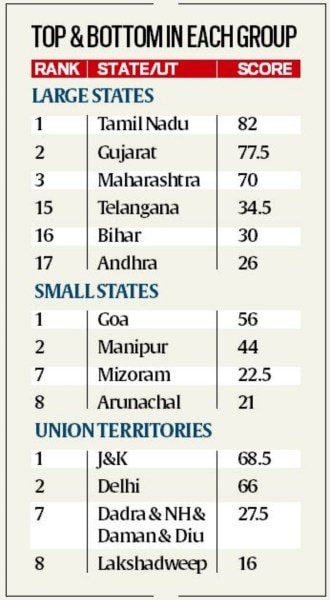Last week, the Food Safety and Standards Authority of India (FSSAI) released the State Food Safety Index (SFSI) 2021-22. A look at how the index assesses and ranks states, and their performances.

Developed by the FSSAI, the index aims to measure the performance of states and Union Territories on selected “parameters” of food safety. According to the FSSAI, the index is aimed at encouraging states and UTs to “improve their performance and work towards establishing a proper food safety ecosystem in their jurisdiction…”
 The SFSI is released annually for a financial year. For instance, the latest SFSI, released on World Food safety Day, June 7, is for the fiscal 2021-22. This is the fourth edition of the SFSI since its inception in 2018-19.
The SFSI is released annually for a financial year. For instance, the latest SFSI, released on World Food safety Day, June 7, is for the fiscal 2021-22. This is the fourth edition of the SFSI since its inception in 2018-19.
Which are these food safety parameters?
The SFSI takes into account the performance of the states on five key parameters, each of which is assigned a different weightage in the assessment.
HUMAN RESOURCES & INSTITUTIONAL DATA: This carries a weightage of 20% and measures the “availability of human resources like number of Food Safety Officers, Designated Officers facility of adjudications and appellate tribunals, functioning of State/ District level Steering Committees, pendency of cases and their monitoring and participation in Central Advisory Committee meetings of the Food Authority”.
COMPLIANCE: This carries the highest weightage, 30%. “This is the most important parameter and measures overall coverage of food businesses in licensing & registration commensurate with size and population of the State/UTs, special drives and camps organized, yearly increase, promptness and effectiveness in issue of state licenses/ registrations,” the FSSAI says. “Promptness” in attending to consumer grievances, and availability of a help desk and web portals, too, come under this parameter.
🚨 Limited Time Offer | Express Premium with ad-lite for just Rs 2/ day 👉🏽 Click here to subscribe 🚨
Story continues below this ad
FOOD TESTING—INFRASTRUCTURE AND SURVEILLANCE: Weighted at 20%, this measures the “availability of adequate testing infrastructure with trained manpower in the States/ UTs for testing food samples”. The FSSAI says, “The States/ UTs with NABL accredited labs and adequate manpower in the labs score more in this parameter.” It takes into account the “availability and effective utilization” of Mobile Food Testing Labs and registration and utilization of InFoLNet (Indian Food Laboratories Network).
TRAINING & CAPACITY BUILDING: This parameter carries the lowest weightage, at 10%. It measures states’ performance on training and capacity building of regulatory staff.
CONSUMER EMPOWERMENT: This carries a weightage of 20%. It evaluates the states and UTs on their performance on various consumer empowering initiatives of FSSAI, such as participation in Food Fortification, Eat Right Campus, BHOG (Blissful Hygienic Offering to God), Hygiene Rating of Restaurants, Clean Street Food Hubs, etc.
Besides, the states’ initiatives for creating consumer awareness are also considered under this parameter.

How is the states and UTs assessed?
Story continues below this ad
The states and Union Territories are not assessed and ranked together. They are segregated into three categories — large states, small states and UTs— and assessed separately within their respective categories, based on their performance on the selected food safety parameters.
“The assessment and evaluation of each category are done by separate teams comprising of outside experts for food testing and food & nutrition professionals in addition to FSSAI officials,” the FSSAI says.
These expert teams examine details received from the states and UTs. They also interact with the states/UTs through video-conferencing for verification and confirmation of data.
How have the states and UTs performed this year?
In the category of the 20 large states, Tamil Nadu with an overall score of 82 out of 100 has performed the best and been ranked 1st on SFSI 2021-22, while Andhra Pradesh with an overall score of 26 has been ranked at the bottom —17th place (some states share a common rank).
Story continues below this ad
Following Tamil Nadu in the rankings of the larger states are Gujarat (rank 2nd with a score 77.5), Maharashtra (3rd with 70), Himachal Pradesh (4th with 65.5) and West Bengal and Madhya Pradesh (sharing 5th with a score of 58.5).
Bihar (rank 16th, score 30), Telangana (rank 15th , score 34.5), Assam (rank 14th, score 35) and Chhattisgarh and Haryana (rank 13th, score 38) join Andhra Pradesh in the bottom 5 among the large states on the SFSI for the large states.
Among the remaining 8 large states, Kerala with a score of 57 has been ranked at 6th, Uttarakhand (score 55) at 7th, Odisha and Uttar Pradesh (both 54.5) at 8th, Karnataka (score 52.5) at 9th, Rajasthan (score 50.5) at 10th, Punjab (score 45) at 11th and Jharkhand (41.5) at 12th.
Among the eight small states, Goa with a score of 56 has been ranked at the top, while Arunachal Pradesh (rank 8th and score 21) is at the bottom.
Story continues below this ad
Among the eight Union Territories, Jammu and Kashmir with a score of 68.5 has been ranked 1st and Lakshadweep (score 16) as the bottom. Delhi with a score of 66 has been ranked at 2nd place.










































